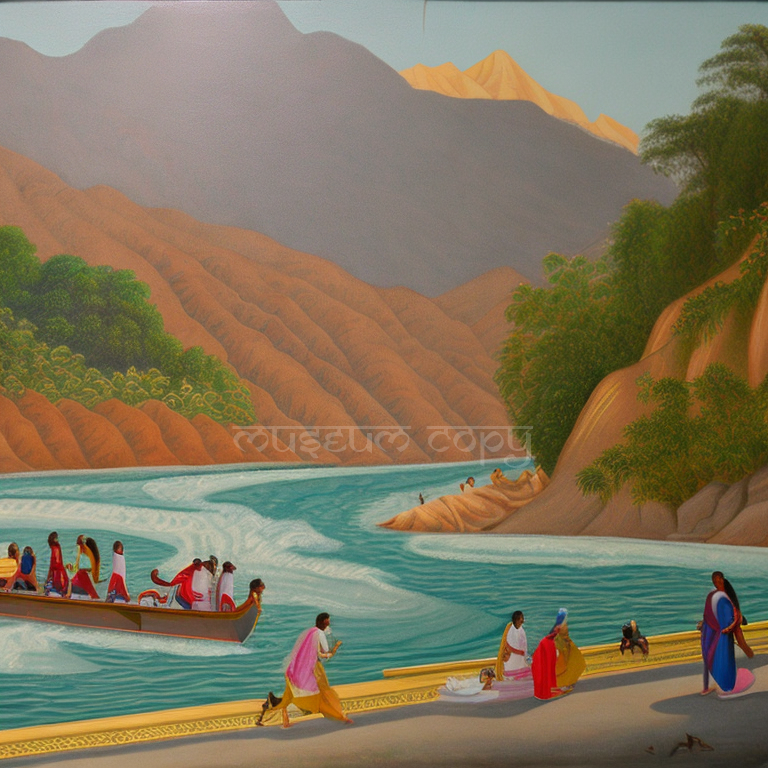Profile: Raja Ravi Varma
•

Raja Ravi Varma, born on April 29, 1848, in Kilimanoor, Travancore (present-day Kerala, India), was a renowned Indian painter and artist who played a significant role in shaping the art landscape of South India. He is often considered one of the pioneers of modern Indian art and is celebrated for his remarkable contributions to the depiction of Indian mythology and the portrayal of Indian women.
Raja Ravi Varma belonged to the royal family of Kilimanoor, and his exposure to the cultural and artistic heritage of his ancestors greatly influenced his artistic journey. He received initial artistic training from his uncle, Raja Raja Varma, and later honed his skills by studying European academic techniques under Dutch portraitist Theodor Jenson. This amalgamation of Indian tradition and Western techniques became a defining characteristic of Ravi Varma's style.
Raja Ravi Varma belonged to the royal family of Kilimanoor, and his exposure to the cultural and artistic heritage of his ancestors greatly influenced his artistic journey. He received initial artistic training from his uncle, Raja Raja Varma, and later honed his skills by studying European academic techniques under Dutch portraitist Theodor Jenson. This amalgamation of Indian tradition and Western techniques became a defining characteristic of Ravi Varma's style.
Vibrant Colors, Detail
Ravi Varma's paintings were known for their vibrant colors, attention to detail, and realistic portrayal of human figures. He drew inspiration from Hindu mythology, epics such as the Ramayana and Mahabharata, and literary works like Kalidasa's Shakuntala. His ability to bring these mythological and literary characters to life through his art made his works immensely popular and accessible to a wide audience.
One of Ravi Varma's significant contributions was the introduction of the lithographic printing technique in India. By employing this method, he made his art accessible to a larger audience and played a crucial role in the democratization of art. His prints, depicting Hindu gods and goddesses, mythological scenes, and Indian women, reached far and wide, transcending regional boundaries and cultural barriers. This not only brought him fame but also fostered a sense of pride and cultural identity among the masses.
One of Ravi Varma's significant contributions was the introduction of the lithographic printing technique in India. By employing this method, he made his art accessible to a larger audience and played a crucial role in the democratization of art. His prints, depicting Hindu gods and goddesses, mythological scenes, and Indian women, reached far and wide, transcending regional boundaries and cultural barriers. This not only brought him fame but also fostered a sense of pride and cultural identity among the masses.
Women in Varma's Art
Ravi Varma's portrayal of Indian women revolutionized the way they were depicted in art. He moved away from the traditional idealized and static representations and portrayed them with a sense of naturalism and emotion. His portrayal of women as strong, independent, and dignified beings challenged prevailing social norms and paved the way for a more progressive outlook.
Impact on South Asian Art
The impact of Raja Ravi Varma's work on South Indian art cannot be overstated. He not only transformed the artistic landscape by blending Indian and Western styles but also brought art to the common people through his prints. His paintings continue to be celebrated and are cherished as national treasures in India. His legacy lives on through the Raja Ravi Varma Heritage Foundation, established to preserve his art and promote his ideals.
Raja Ravi Varma's importance to South Indian art lies in his ability to bridge the gap between tradition and modernity, his popularization of Indian mythology, his innovative use of lithographic prints, and his redefinition of the portrayal of Indian women. His artistic contributions have left an indelible mark on the art world, inspiring generations of artists and continuing to influence the appreciation and understanding of Indian art to this day.
Raja Ravi Varma's importance to South Indian art lies in his ability to bridge the gap between tradition and modernity, his popularization of Indian mythology, his innovative use of lithographic prints, and his redefinition of the portrayal of Indian women. His artistic contributions have left an indelible mark on the art world, inspiring generations of artists and continuing to influence the appreciation and understanding of Indian art to this day.